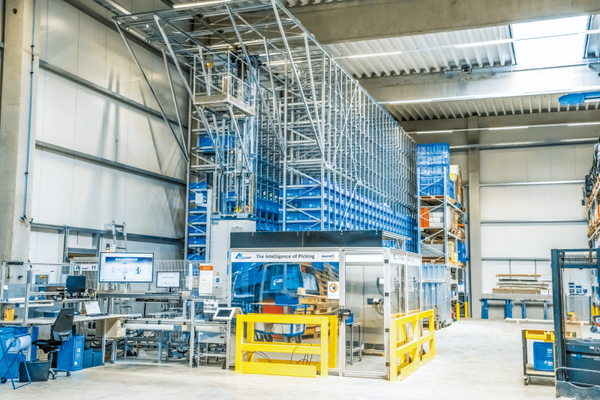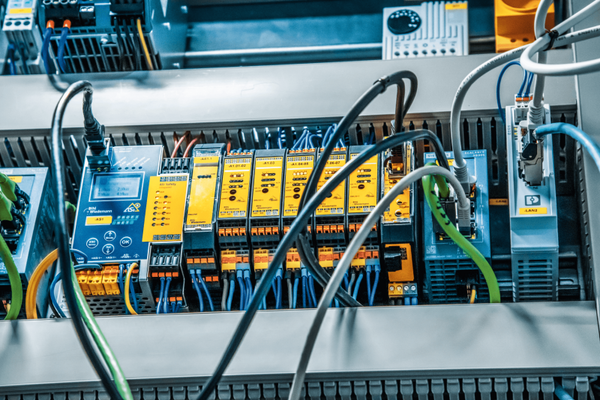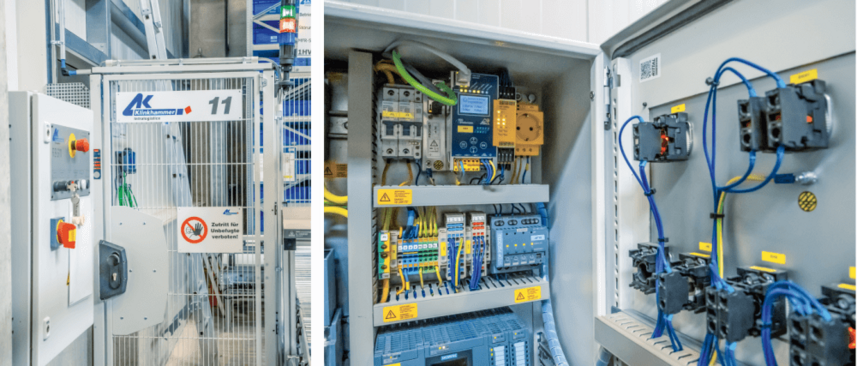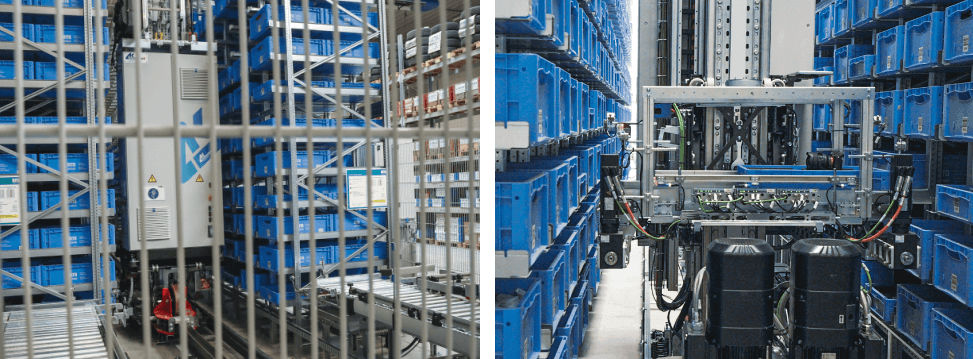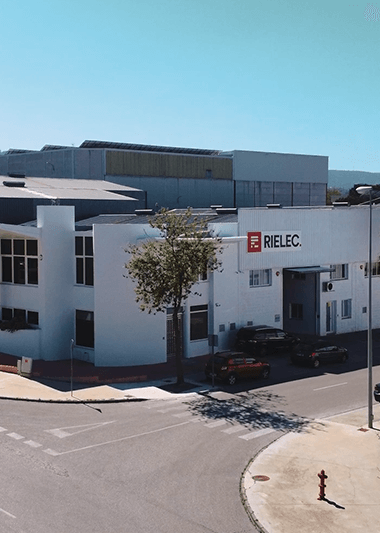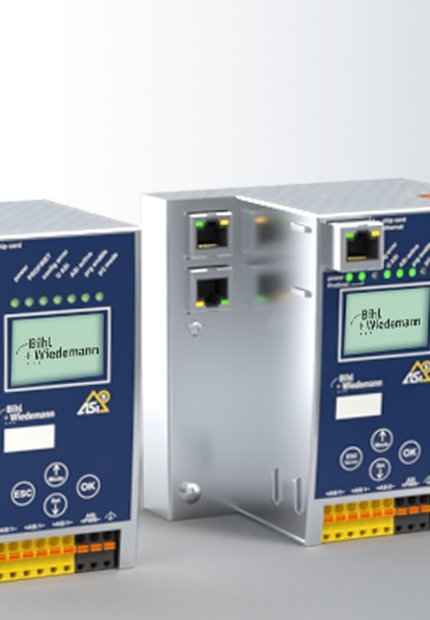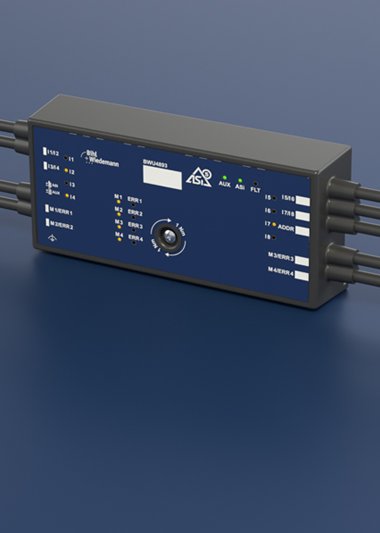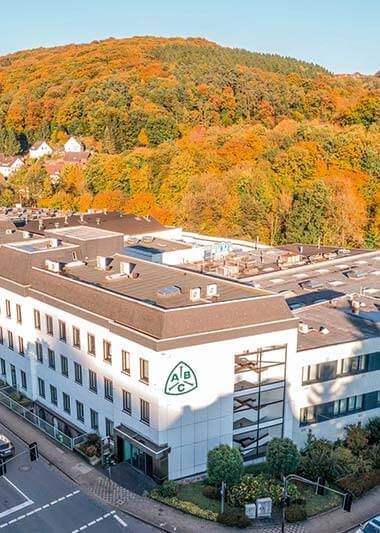- AS-Interface
Stacker crane from Klinkhammer: MOVING SAFELY THROUGH THE AISLES
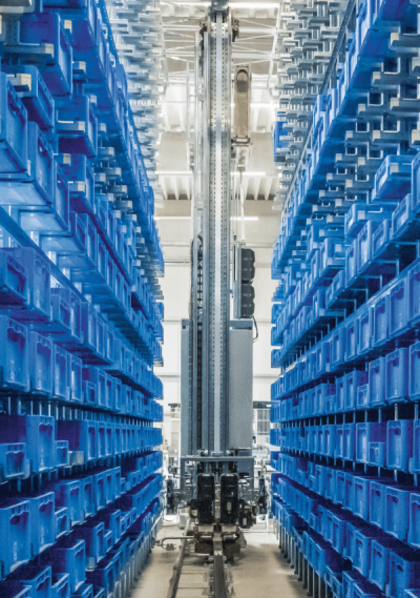
The Klinkhammer Group, originally founded in 1972 in Nuremberg as an “engineering office with innovative logistics planning”, is a family-owned, medium size group with an international orientation. The focus of Klinkhammer Logistics is on designing efficient material flow in the warehouse, using holistic, automated logistics solutions. Accordingly the company offers innovative logistics concepts, installation of the warehouse technology and future-oriented software for a variety of industries from a single source.
The objective is always to develop the most economically and effective solution for the customer – taking into account all the relevant market trends and developments. With 50 years of experience in automated storage, material handling, picking and distribution technology, Klinkhammer is an innovative intralogistics provider in Europe for warehouse automation.
Klinkhammer and AS-Interface – a long tradition
Simple installation, great functionality and flexibility, low costs – and all that with high user convenience. AS-Interface has established itself as the internationally standardized wiring system in modern conveying and material handling technology as well, to which Bihl+Wiedemann has contributed greatly with their comprehensive product range and their various hardand software tools for commissioning the ASi networks.
Klinkhammer as well has for many years relied on ASi and (ASi) Safety solutions from Bihl+Wiedemann in their material handling technology, using among other things the compact cable duct modules for motorized rollers as well as standard and safety I/O modules in IP20 and IP67. Also used are PROFINET gateways which send the I/O data as well as detailed diagnostic information directly to the control. Using the optional safety control in the gateways, the safetyrelated signals can be processed directly and locally, eliminating the need for a higher level safety control.
According to Alexander Ruhmann, responsible for electronic design at Klinkhammer, an essential consideration in choosing Bihl+Wiedemann was the fact that the ASi gateways (ASi master and fieldbus connection in one stainless steel housing), in contrast to the devices from other manufacturers, were early to include a display, making them significantly more maintenance- friendly.
And the safety technology, even for larger material handling applications, is ideally implemented using ASi Safety according to A. Ruhmann, since it is often the case that only the data from simple sensors needs to be collected but from widely different locations in the field. “Light barriers, here and there a safety light curtain, every few meters an E-STOP button, perhaps a protective door or two – ASi Safety is simply perfect for this, especially in the field of material handling”.
Stacker crane with safety technology from Bihl+Wiedemann
Based on the positive experiences, the company has made over the past few years with ASi and ASi Safety solutions, as well as the possibilities that these offer, Klinkhammer decided for the first time on the safety technology of a stacker crane (S/RM) for an automated high-bay warehouse with a safety solution from Bihl+Wiedemann.
In designing an approximately 2-ton and approximately 8 meter high stacker crane for containers, moving through an aisle on a rail at a speed of up to 6 m/s and using a load handling device (LHD) to automatically load and unload shelves to the left and right of the aisle at different heights, the following requirements had to be met:
- The safety concept had to meet the requirements of the new EN 528 for storage and retrieval cranes
- Safe communication between the inside (the S/RM on the rail) and the outside (the control cabinet in front of the safe area at the aisle entrance and the non-travelling buffers) had to be possible to implement
- The safety solutions should function without expensive sliding contacts and without the use of an additional safety control
- Safe position and motion monitoring had to be ensured within the aisle
- Safe position and motion monitoring should be implemented using a barcode positioning system
- The safety technology should be capable of being processed locally on the S/RM
- Communication between the S/RM and control cabinet should be via data light barrier - The position of the S/RM must be known by the control unambiguously and at all times
- die Position des RBGs muss der Steuerung zu jedem Zeitpunkt eindeutig bekannt sein.
High-bay warehouse
According to industry guidelines a rack is considered a high-bay warehouse when it is 7.50 m tall or more. Automated high-bay warehouses can be operated by so-called storage and retrieval machines (S/RMs), which receive and automatically execute travel assignments over a warehouse management and material handling system. The machines are controlled by complex control systems. Via the material handling system the materials are transported to the high-bay warehouse and from there to the picking area, production or shipping. Automated high-bay warehouses were created mainly in order to save floor space, increase storage capacity, shorten the logistics chain and improve delivery quality.
Safe communication between inside and outside
For (safe) communication between the control cabinet outside the active area of the S/RM and the stacker crane itself two ASi-5/ASi-3 PROFINET gateways with integrated safety monitor (BWU3863) are used. Both gateways are connected to each other via Safe Link, the safe coupling technology from Bihl+Wiedemann.
Safe Link can be transmitted over standard Ethernet or the fieldbus. No additional wiring is necessary for the safety communication, and the gateway can be expanded locally over AS-Interface with additional safe and standard I/Os. For the area between the barrier and the S/RM, i.e. where no hardwired communication is possible, a data light barrier is used. With this data light barrier, the Safe Link data and the non-safe signals can be stably transmitted optically over a distance of up to 120 m.
The second ASi-5/ASi-3 PROFINET Safety Gateway monitors the stationary safety technology. These data are made available to the second gateway on the stacker crane via Safe Link, with the gateway itself controlling the safety technology of the S/RM.
Safe position and motion monitoring
For safe position and motion monitoring of the S/RM, which accelerates at 3.5 m/s2 and reaches a speed of 6 m/s, an ASi Speed Monitor (BWU2849) from Bihl+Wiedemann is used.
In addition to the position of the stacker crane the ASi Speed Monitor, together with the gateway, also monitors additional safety requirements specified in EN 528. Depending on the operating mode, these can be speed, acceleration and braking ramps, rotation direction, standstill as well as safe end positions. For diagnostic and control purposes these data are sent nonsafe over the fieldbus to the control.
The load handling device (LHD) on the stacker crane can remove materials from a defined location in the high-bay or precisely place them in that same location. In addition it can hand over materials removed at the aisle entrance to the conveyor belt for further transport or remove them from the belt for storage. To ensure that the throughput of goods in the high-bay warehouse is as high as possible, it is essential that the S/RM accelerates and also decelerates again as quickly as possible. However, the mechanical buffers at the beginning and at the end of the aisle can only absorb part of the maximum kinetic energy of the stacker crane.
Therefore, the speed at the edge areas must be safely monitored and reduced at the right time. Ideally, this is achieved using monitored brake ramps, which can also be safely evaluated by the Speed Monitor. If the acceleration or braking behavior is not correct, the safety technology also intervenes here and ensures that the S/RM comes to a safe stop.
In contrast to the travel path within the aisle (‘X-direction’), which must be safely monitored because, for example, in manual operation or commissioning mode an operator may be present in the aisle, safe monitoring of the stroke (‘Y-direction’) is not necessary for a container S/RM system, since only boxes are transported on the LHD.
The situation is different for a palletized S/RM system, which is usually much larger and where a person can also travel upwards in a cabin. In this case, the lift also needs to be monitored in terms of safety. What at first glance sounds like a significantly more complex application can, on closer inspection, be implemented with relatively little effort using the safety solution from Bihl+Wiedeman by simply using a second ASi Speed Monitor for the ‘Y direction’ in addition to the Speed Monitor for the aisle.
Whether in material handling or in storage and retrieval machines – the ASi and (ASi Safety) solutions from Bihl+Wiedemann have proven and established themselves in many safe and non-safe applications. And if Alexander Ruhmann has anything to say about it, this will not change in the future – on the contrary, existing and new products as well as further technological developments still offer great potential.


